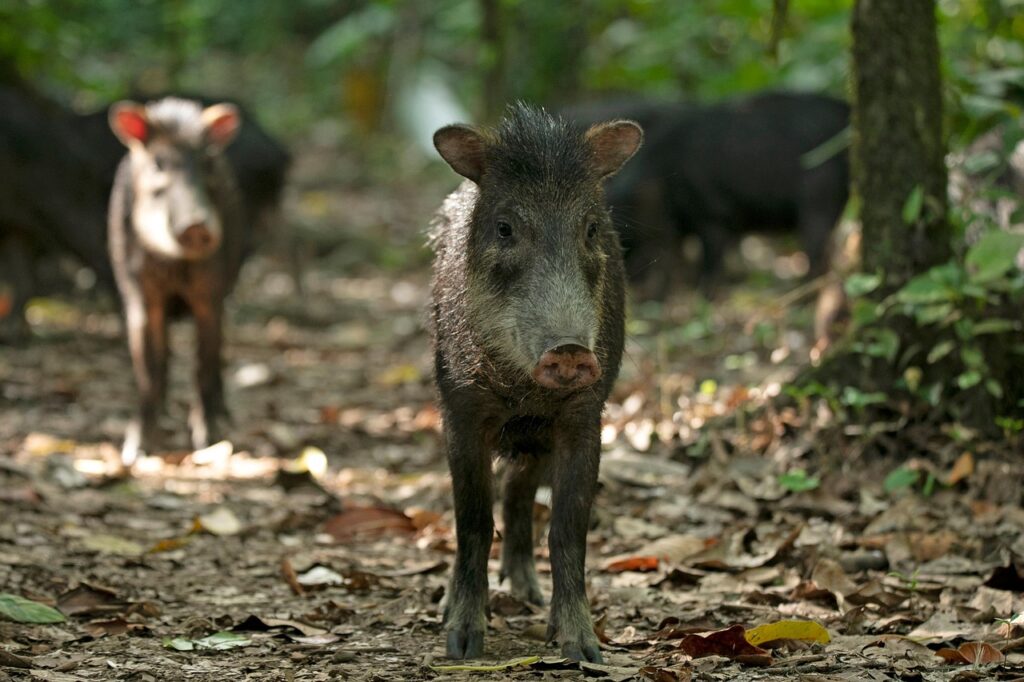Panama

Shy Peccaries
Panama is a crossing point. A place where continents meet, species migrate, and oceans breathe on either side. But it’s more than a bridge — it’s a jungle-wrapped riddle. Sloths sleep above shipping lanes. Jaguars walk near radar towers. Harpy eagles hunt in trees that stand just miles from skyscrapers. In Panama, wildlife doesn’t just survive the modern world. It weaves through it — fluid, fearless, and often unseen until it wants to be.
This is a country of edges: rainforest pressed against city, mangrove against sea, cloud forest fading into pasture. Nothing here fits neatly into zones or categories. Instead, life flows — between ecosystems, between hemispheres, between the wild and the built. The result? A landscape where you can spot a keel-billed toucan on a morning walk and hear howler monkeys echo through afternoon rain.
Not a Transit Country. A Wild One.
Wildlife on the Move
Panama is alive with travelers — not just humans, but animals in transit. Birds migrating from Canada to South America stop here in clouds. Whales move along both coasts. Butterflies rise in great waves through the jungle. Even the land-based animals move between North and South, making this a place of mingling — not just genetically, but energetically. You can feel it in the forests: a sense that everything is connected, passing through, or coming home.
Animals That Belong to Two Worlds
Wildlife Doesn’t Ask Permission Here
It enters the city. Crosses your path. Calls from behind leaves. You don’t have to go far to find it — you just have to be willing to notice. A basilisk running across a hotel path. A bat roosting under a bridge. A raccoon stealing mangoes from a garden fence. In Panama, wildness doesn’t wait for you to “go into nature.” It shows up — unexpected and unapologetic.
Final Reflections
Panama isn’t a background. It’s a threshold — between two continents, two oceans, two ways of seeing the world. You can chase wildlife here. Or you can stand still and let it move past you, as it always has. In a land built for connection, nothing stays still for long. But if you’re patient, Panama will show you that even in the narrowest places, life expands.
This is a country of edges: rainforest pressed against city, mangrove against sea, cloud forest fading into pasture. Nothing here fits neatly into zones or categories. Instead, life flows — between ecosystems, between hemispheres, between the wild and the built. The result? A landscape where you can spot a keel-billed toucan on a morning walk and hear howler monkeys echo through afternoon rain.
Not a Transit Country. A Wild One.
- Darien Gap: The last truly roadless stretch of Central America — a dense, difficult, protected frontier. Home to jaguars, tapirs, giant anteaters, harpy eagles, and Indigenous communities who know this land like a second skin.
- Canal Zone Forests: Just outside Panama City, national parks like Soberanía and Metropolitan are teeming with monkeys, sloths, toucans, and tamarins — all within view of the skyline.
- Cloud Forests of Chiriquí: In the west, where the highlands cool the air and the quetzals nest. Orchids grow wild, frogs sing under mossy logs, and every trail feels like the beginning of something secret.
- Bocas del Toro & Caribbean Coast: Mangrove tunnels, coral reefs, and rainforest islands where poison frogs glow, bats fish, and sloths nap in trees just above the tide.
- Coiba National Park: Once a prison island, now a biodiversity hotspot. Hammerhead sharks, whale sharks, sea turtles, and tropical fish swarm coral gardens protected by isolation.
Wildlife on the Move
Panama is alive with travelers — not just humans, but animals in transit. Birds migrating from Canada to South America stop here in clouds. Whales move along both coasts. Butterflies rise in great waves through the jungle. Even the land-based animals move between North and South, making this a place of mingling — not just genetically, but energetically. You can feel it in the forests: a sense that everything is connected, passing through, or coming home.
Animals That Belong to Two Worlds
- Harpy Eagle: One of the largest, most powerful eagles in the world — and Panama is one of the last places you might still see one in the wild.
- Geoffroy’s Tamarin: Tiny, expressive, and full of attitude — often spotted in the trees near the canal zone, moving in noisy family troops.
- Three-Toed Sloth: Iconic, sleepy, and easier to find in Panama than almost anywhere else — often seen hanging in parks, gardens, and roadside trees.
- Glass Frog: Transparent and delicate — a reminder of how much you miss when you only look for the big things.
- Jaguar: Elusive and still present — especially in Darién and protected corridors that allow them to move north and south through the isthmus.
Wildlife Doesn’t Ask Permission Here
It enters the city. Crosses your path. Calls from behind leaves. You don’t have to go far to find it — you just have to be willing to notice. A basilisk running across a hotel path. A bat roosting under a bridge. A raccoon stealing mangoes from a garden fence. In Panama, wildness doesn’t wait for you to “go into nature.” It shows up — unexpected and unapologetic.
Final Reflections
Panama isn’t a background. It’s a threshold — between two continents, two oceans, two ways of seeing the world. You can chase wildlife here. Or you can stand still and let it move past you, as it always has. In a land built for connection, nothing stays still for long. But if you’re patient, Panama will show you that even in the narrowest places, life expands.
